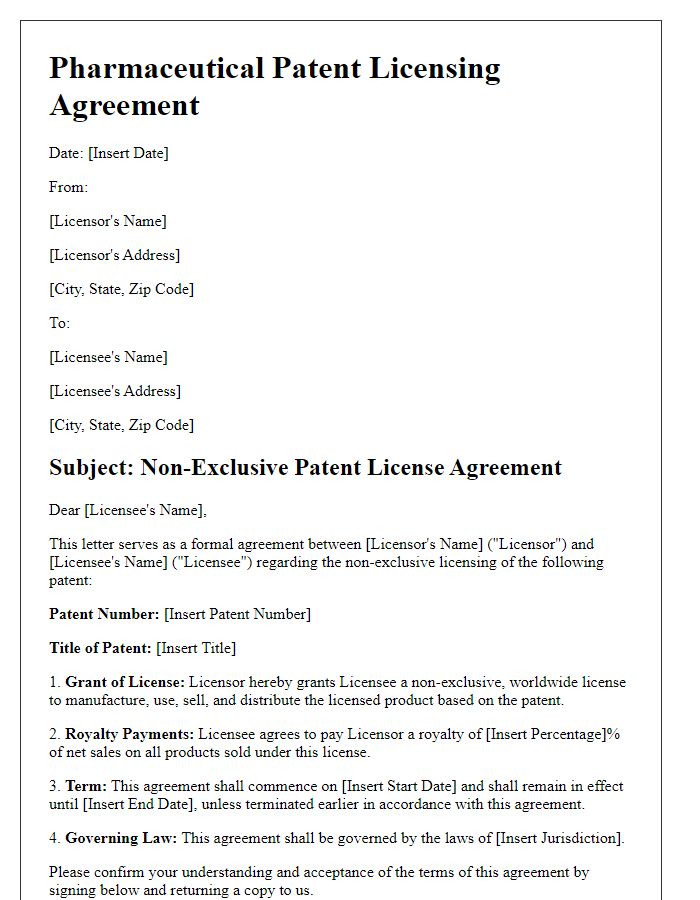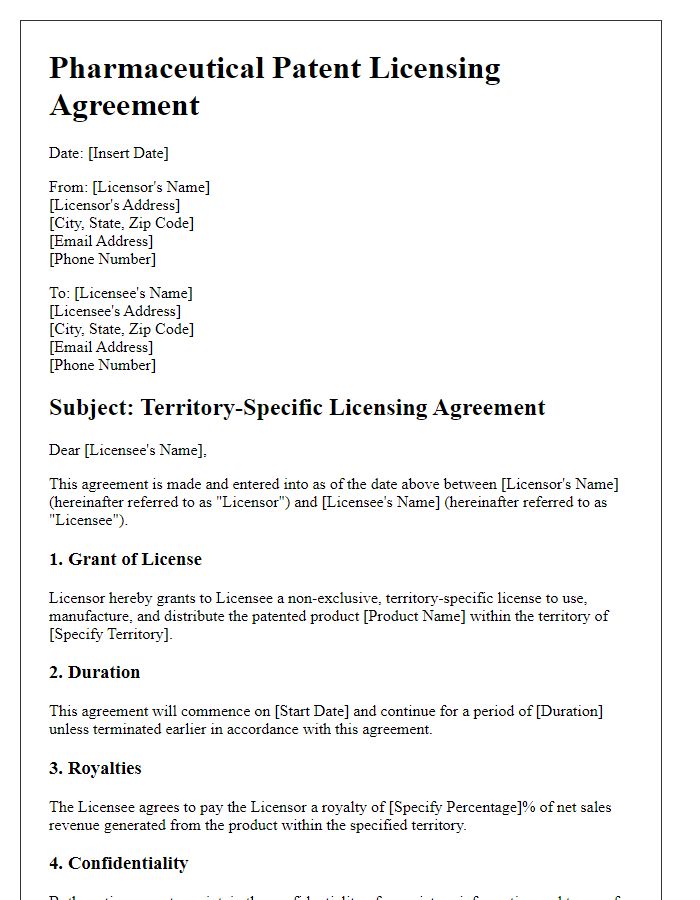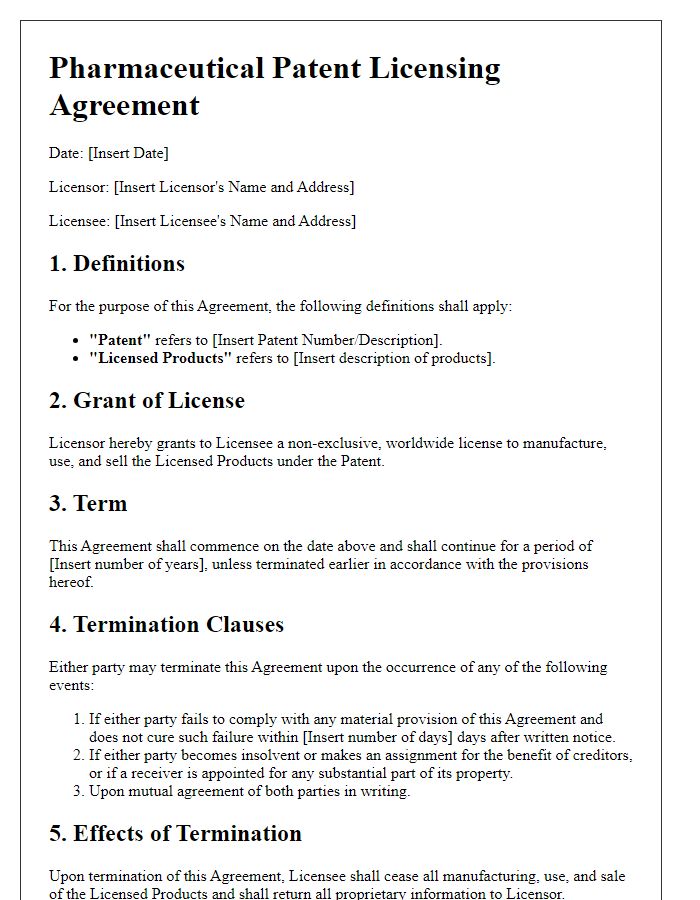Are you navigating the complex world of pharmaceutical patent licensing? Crafting a solid agreement is crucial for protecting your innovations while ensuring mutually beneficial arrangements. This article will guide you through the essential components of a patent licensing agreement, helping you avoid common pitfalls and misunderstandings. Join us as we delve deeper into this topic and equip yourself with the knowledge to create effective licensing contracts.

Parties Involved
A pharmaceutical patent licensing agreement outlines the terms between parties involved in the licensing of specific pharmaceutical patents, such as drug formulations or manufacturing processes. The parties typically include the Licensor, a pharmaceutical company holding the patent rights, and the Licensee, an entity or another pharmaceutical company seeking permission to utilize, manufacture, or sell the patented product. Important details include the effective date of the agreement, the geographical territories where the license is valid (such as North America or Europe), and obligations related to compliance with regulatory agencies like the FDA (Food and Drug Administration) or EMA (European Medicines Agency). Additionally, financial terms such as royalty rates, upfront payments, and milestones further define the relationship. Parties must ensure clarity on rights granted and responsibilities to avoid potential disputes and ensure a successful collaboration.
Definitions and Terminology
Pharmaceutical patent licensing agreements involve specific legal terms that define essential aspects of the agreement. The "Grant of License" refers to the permission granted by the patent holder, allowing another party to use, manufacture, or sell the patented pharmaceutical innovation. "Field of Use" delineates the specific pharmaceutical sectors or indications for which the license is granted, ensuring clarity on the scope. "Royalty Rates" indicate the financial compensation structure, often based on sales percentages, and may vary with market categories. "Term" specifies the duration of the licensing agreement, often spanning 10 to 20 years from the effective date, aligned with patent life. "Improvements" encompass any enhancements or new developments related to the original patent, demanding consideration for additional licensing terms. "Confidentiality" clauses protect proprietary information shared between the parties, crucial in the competitive pharmaceutical industry to maintain trade secrets. Clear definitions foster mutual understanding and compliance in the pharmaceutical licensing landscape, protecting both innovators and marketers.
Grant of License
A pharmaceutical patent licensing agreement establishes the terms under which a patent holder grants rights to another party for the use of an invention. The grant of license typically specifies the scope of the licensed rights, including whether the license is exclusive or non-exclusive, the territory (geographical area) where the rights apply, and the duration of the license (specified period such as 5 years). Key components include the obligations of both parties, such as royalty payments (monetary compensation based on sales), reporting requirements, and maintenance of patent validity. The agreement may also include quality control measures to ensure products meet industry standards, particularly important in the pharmaceutical industry to ensure patient safety. Furthermore, conditions for termination of the license, dispute resolution methods, and indemnification clauses protecting against liability risks are often included to safeguard both parties throughout the licensing relationship.
Financial Obligations
In a pharmaceutical patent licensing agreement, financial obligations tend to encompass various critical elements, including upfront fees, milestone payments, and royalty rates. Upfront fees, often reaching hundreds of thousands to several million dollars, are paid at the agreement's initiation to secure licensing rights for drug compounds or formulations. Milestone payments, usually in the range of tens of thousands to millions, are contingent upon significant development milestones such as successful clinical trial phases or regulatory approvals, like those required by the FDA (Food and Drug Administration) in the United States. Royalty rates, typically expressed as a percentage ranging from 2% to 15% of net sales, apply to any commercial sales of the licensed pharmaceutical products, ensuring ongoing financial returns for the patent holder. Additionally, the agreement may stipulate payment schedules, reporting requirements, and provisions for audit rights to verify compliance.
Intellectual Property Rights
Pharmaceutical patent licensing agreements typically establish the legal parameters of intellectual property rights associated with innovative drugs, formulations, and manufacturing processes. These agreements often delineate the specific patents involved, such as those filed under the United States Patent and Trademark Office (USPTO) or the European Patent Office (EPO), covering unique compounds or methods pertinent to the pharmaceutical industry. The licensing terms may include key metrics such as royalty rates, which often range between 3% to 10% of gross sales, and duration of the agreement, commonly spanning 5 to 20 years. Additionally, the agreement must clarify territorial rights, specifying which countries or regions, like North America or the European Union, the licensee can operate in. Compliance with regulatory bodies, such as the Food and Drug Administration (FDA) in the U.S., is crucial to protect both parties' interests and ensure that the licensed products meet safety and efficacy standards. Confidentiality clauses are often incorporated to safeguard sensitive information regarding research and development processes, ensuring that proprietary data remains protected throughout the license term.
Letter Template For Pharmaceutical Patent Licensing Agreement Samples
Letter template of pharmaceutical patent licensing agreement for exclusive rights.

Letter template of pharmaceutical patent licensing agreement for non-exclusive rights.

Letter template of pharmaceutical patent licensing agreement with royalty payments.

Letter template of pharmaceutical patent licensing agreement for territory-specific licensing.

Letter template of pharmaceutical patent licensing agreement with performance milestones.

Letter template of pharmaceutical patent licensing agreement for joint research collaboration.

Letter template of pharmaceutical patent licensing agreement with termination clauses.

Letter template of pharmaceutical patent licensing agreement for technology transfer.

Letter template of pharmaceutical patent licensing agreement addressing infringement disputes.








Comments